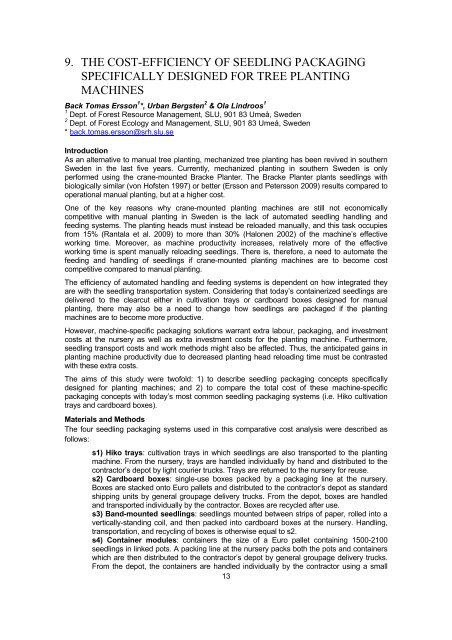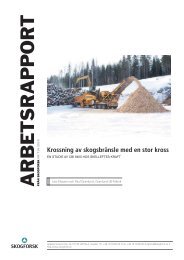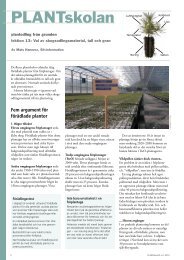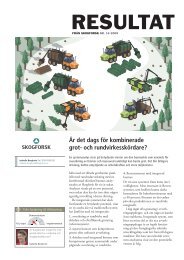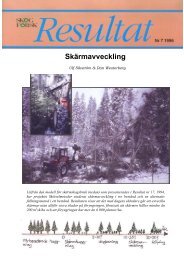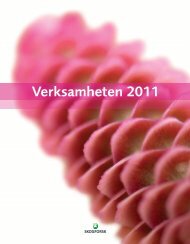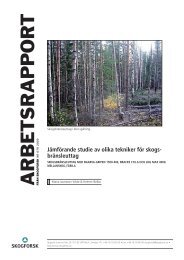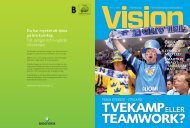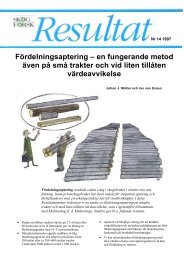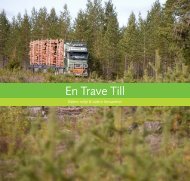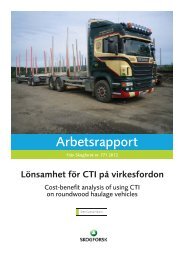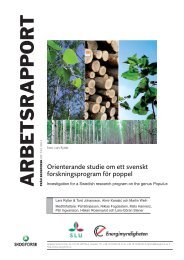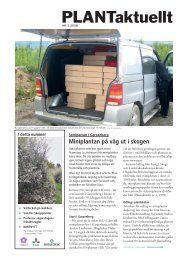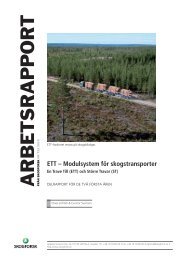Download pdf - Skog og landskap
Download pdf - Skog og landskap
Download pdf - Skog og landskap
Create successful ePaper yourself
Turn your PDF publications into a flip-book with our unique Google optimized e-Paper software.
9. THE COST-EFFICIENCY OF SEEDLING PACKAGING<br />
SPECIFICALLY DESIGNED FOR TREE PLANTING<br />
MACHINES<br />
Back Tomas Ersson 1 *, Urban Bergsten 2 & Ola Lindroos 1<br />
1 Dept. of Forest Resource Management, SLU, 901 83 Umeå, Sweden<br />
2 Dept. of Forest Ecol<strong>og</strong>y and Management, SLU, 901 83 Umeå, Sweden<br />
* back.tomas.ersson@srh.slu.se<br />
Introduction<br />
As an alternative to manual tree planting, mechanized tree planting has been revived in southern<br />
Sweden in the last five years. Currently, mechanized planting in southern Sweden is only<br />
performed using the crane-mounted Bracke Planter. The Bracke Planter plants seedlings with<br />
biol<strong>og</strong>ically similar (von Hofsten 1997) or better (Ersson and Petersson 2009) results compared to<br />
operational manual planting, but at a higher cost.<br />
One of the key reasons why crane-mounted planting machines are still not economically<br />
competitive with manual planting in Sweden is the lack of automated seedling handling and<br />
feeding systems. The planting heads must instead be reloaded manually, and this task occupies<br />
from 15% (Rantala et al. 2009) to more than 30% (Halonen 2002) of the machine’s effective<br />
working time. Moreover, as machine productivity increases, relatively more of the effective<br />
working time is spent manually reloading seedlings. There is, therefore, a need to automate the<br />
feeding and handling of seedlings if crane-mounted planting machines are to become cost<br />
competitive compared to manual planting.<br />
The efficiency of automated handling and feeding systems is dependent on how integrated they<br />
are with the seedling transportation system. Considering that today’s containerized seedlings are<br />
delivered to the clearcut either in cultivation trays or cardboard boxes designed for manual<br />
planting, there may also be a need to change how seedlings are packaged if the planting<br />
machines are to become more productive.<br />
However, machine-specific packaging solutions warrant extra labour, packaging, and investment<br />
costs at the nursery as well as extra investment costs for the planting machine. Furthermore,<br />
seedling transport costs and work methods might also be affected. Thus, the anticipated gains in<br />
planting machine productivity due to decreased planting head reloading time must be contrasted<br />
with these extra costs.<br />
The aims of this study were twofold: 1) to describe seedling packaging concepts specifically<br />
designed for planting machines; and 2) to compare the total cost of these machine-specific<br />
packaging concepts with today’s most common seedling packaging systems (i.e. Hiko cultivation<br />
trays and cardboard boxes).<br />
Materials and Methods<br />
The four seedling packaging systems used in this comparative cost analysis were described as<br />
follows:<br />
s1) Hiko trays: cultivation trays in which seedlings are also transported to the planting<br />
machine. From the nursery, trays are handled individually by hand and distributed to the<br />
contractor’s depot by light courier trucks. Trays are returned to the nursery for reuse.<br />
s2) Cardboard boxes: single-use boxes packed by a packaging line at the nursery.<br />
Boxes are stacked onto Euro pallets and distributed to the contractor’s depot as standard<br />
shipping units by general groupage delivery trucks. From the depot, boxes are handled<br />
and transported individually by the contractor. Boxes are recycled after use.<br />
s3) Band-mounted seedlings: seedlings mounted between strips of paper, rolled into a<br />
vertically-standing coil, and then packed into cardboard boxes at the nursery. Handling,<br />
transportation, and recycling of boxes is otherwise equal to s2.<br />
s4) Container modules: containers the size of a Euro pallet containing 1500-2100<br />
seedlings in linked pots. A packing line at the nursery packs both the pots and containers<br />
which are then distributed to the contractor’s depot by general groupage delivery trucks.<br />
From the depot, the containers are handled individually by the contractor using a small<br />
13


